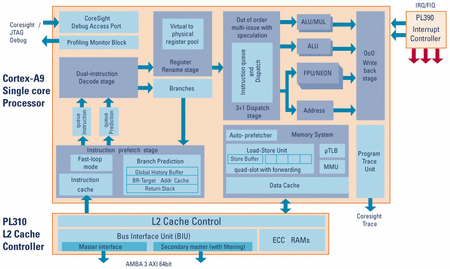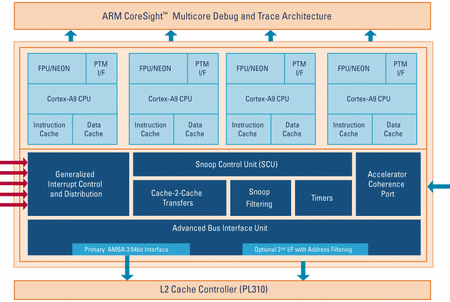ARM announces 28nm Cortex-A9 implementation
Oct 7, 2009 — by LinuxDevices Staff — from the LinuxDevices Archive — 120 viewsGlobalfoundries, spun off by AMD last year, has announced a “long-term strategic relationship” with ARM. A first step in the partnership will be the manufacture of ARM Cortex-A9 processors via a 28-nanometer HKMG (high-k metal gate) process, according to the companies.
AMD spun off Globalfoundries last year in a joint venture with ATIC (Advanced Technology Investment Company) of Abu Dhabi, and, until recently, has been the fab company's only customer. In July, Globalfoundries — which operates a manufacturing facility in Dresden, Germany, and is building another in upstate New York — gained STMicroelectronics as a client. (Globalfoundries is also in the process of buying Chartered Semiconductor, another foundry that numbers Broadcomm and Qualcomm among its customers.)
Now, Globalfoundries and ARM say they have signed a "broad agreement on processor implementation and circuit optimization to provide mutual customers with a robust enablement program." The program includes a "full suite" of ARM physical IP, fabric IP, and processor IP, combined with Globalfoundries' HKMG manufacturing capabilities, according to the company.

ARM Cortex A9 in single-core configuration
(Click to enlarge)
Globalfoundries and ARM say the first fruit of their collaboration will be a 28nm implementation of ARM's high-end Cortex-A9 (above). Announced in Oct. 2007, ARM's Cortex-A9 core was promoted from the outset as supporting clock speeds over 1GHz and performance of around 2,000 Dhrystone MIPS. The A9 also arrived with support for ARM's MPCore interconnect technology, pictured below in a quad-core implementation.

ARM Cortex A9 in MPCore configuration
(Click to enlarge)
Originally envisioned as being manufactured on TSMC's 65nm process, the Cortex-A9 has been steadily shrinking, reaping potential savings in both board real estate and power consumption. Last February, for instance, ARM licensee Texas Instruments (TI) announced a 45nm, dual-core Cortex-A9 implementation, the OMAP4430 and OMAP4440, which it said would be sampling during the second half of 2009. Scheduled for volume production during the second half of 2010, the 45nm OMAP4 chips will include Powervr SGX540 graphics and be capable of 1080p video playback, says TI.
More recently, ARM announced new Cortex-A9 implementations, code-named "Osprey," that can achieve clock speeds above 2GHz and are claimed to offer up to twice the performance of Intel's 1.6GHz Atom N270. Designed for TSMC's 40nm process, the dual-core Ospreys can run at 800MHz, consuming 0.5 Watts overall, or at 2GHz, consuming just 1.9 Watts, says ARM. For further details, see our earlier coverage, here.
Globalfoundries and ARM provided no specific claims about the size or power consumption of their forthcoming 28nm Cortex-A9 processors. However, the underlying HKMH technology "is optimized for high-performance processing with minimal leakage, making it an ideal choice for advanced mobile solutions," the companies said in a statement.
Availability
No timetable was provided by Globalfoundries and ARM for the availability of Cortex-A9 processors using 28nm technology. General information on the Cortex-A9 may be found on the ARM website, here.
For additional coverage of the Globalfoundries-ARM partnership, see stories by eWEEK.com, here, and ARS Technica, here.
This article was originally published on LinuxDevices.com and has been donated to the open source community by QuinStreet Inc. Please visit LinuxToday.com for up-to-date news and articles about Linux and open source.